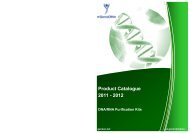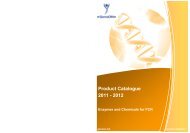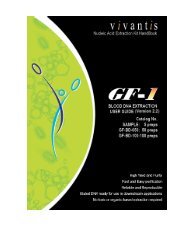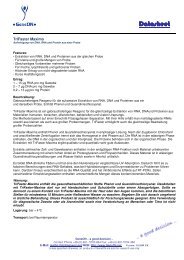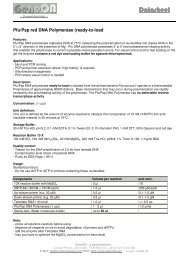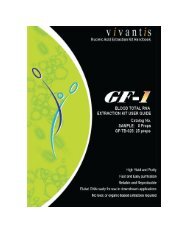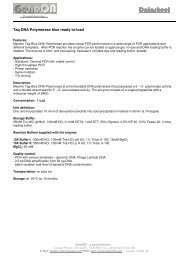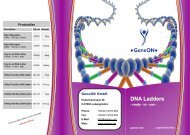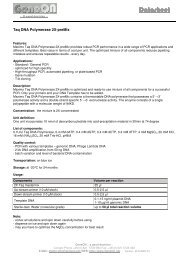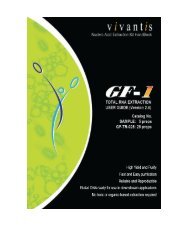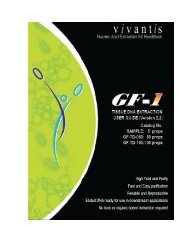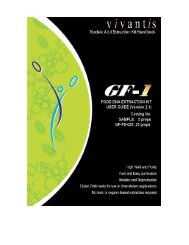GF-1 Plasmid DNA Extraction Kit
GF-1 Plasmid DNA Extraction Kit
GF-1 Plasmid DNA Extraction Kit
- No tags were found...
You also want an ePaper? Increase the reach of your titles
YUMPU automatically turns print PDFs into web optimized ePapers that Google loves.
IntroductionThe <strong>GF</strong>-1 <strong>Plasmid</strong> <strong>DNA</strong> <strong>Extraction</strong> <strong>Kit</strong> is designed for rapid and efficient purification ofhigh copy and low copy plasmid <strong>DNA</strong> without the need for precipitation or organicextractions. This it uses a specially-treated glass filter membrane fixed into a column toefficiently bind <strong>DNA</strong> in the presence of high salt. Combining alkaline lysis-SDS and minicolumnspin technology, up o 20µg of plasmid <strong>DNA</strong> from bacterial cultures can be isolated.Multiple samples can be processed rapidly and with practice, the purification takes less than30 minutes. Optimized buffers ensure only highly pure plasmid <strong>DNA</strong> is extracted and is readyto use in many routine molecular biology applications such as restriction enzyme digestion,radioactive/fluorescence <strong>DNA</strong> sequencing, PCR, ligation, transformation and othermanipulations.Culture Vol. Yield PurityHigh Copy Number <strong>Plasmid</strong> 2ml 2-5µg 1.7-1.9(50-500 copies per cell) 5ml 10-20µg 1.7-1.9Low Copy Number <strong>Plasmid</strong> 2ml 1-3µg 1.7-1.9(1-10 copies per cell) 5ml 5-10µg 1.7-1.9
<strong>Kit</strong> componentsProductCatalog No.5 PrepsSAMPLE50 Preps<strong>GF</strong>-PL-050100 Preps<strong>GF</strong>-PL-100Component<strong>GF</strong>-1 columns 5 50 100Collection tubes 5 50 100Solution 1 (S1)* 1.5ml 15ml 30mlSolution 2 (S2)* 1 1.5ml 15ml 30mlNeutralizing Buffer 2.5ml 25ml 30ml(Buffer NB)Wash Buffer2.4ml 17ml 34ml(concentrate)*RNase A7.5µl 75µl 150µl(DNase-free)*Elution Buffer 1.5ml 10ml 20mlHandbook 1 1 1* Please refer to Reconstitution of Solutions and Storage and Stability before using this kit.The <strong>GF</strong>-1 <strong>Plasmid</strong> <strong>DNA</strong> <strong>Extraction</strong> <strong>Kit</strong> is available as 50 and 100 purifications per kit.The reagents and materials provided with the kit are for research purposes only.
Additional Materials to be Supplied by UserAbsolute Ethanol (>95%)Reconstitution of SolutionsThe bottle labeled Wash Buffer contains concentrated buffer which must be diluted withabsolute ethanol (>95%) before use.The vial of RNase A (DNase-Free) provided is to be added into the bottle labeled S1.For SAMPLE (5 preps),Add 3.5ml of absolute ethanol into the bottle labeled Wash Buffer.Add 1ml of S1 into the vial of RNase A and mix well. Briefly centrifuge and transfer theentire mixture back into the S1 tube. Mix well.For <strong>GF</strong>-PL-050 (50 preps),Add 40ml of absolute ethanol into the bottle labeled Wash Buffer.Add 1ml of S1 into the vial of RNase A and mix well. Briefly centrifuge and transfer theentire mixture back into the S1 bottle. Mix well.For <strong>GF</strong>-PL-100 (100 preps),Add 80ml of absolute ethanol into the bottle labeled Wash Buffer.Add 1ml of S1 into the vial of RNase A and mix well. Briefly centrifuge and transfer theentire mixture back into the S1 bottle. Mix well.Store Wash Buffer at room temperature with bottle capped tight after use.RNase A in S1 should be stable for 6 months when the solution is stored at 2°C - 8°C.
Storage and Stability• Store S1 at 2°C - 8°C after the addition of RNase A.• Store other solutions at 20°C - 30°C.• Ensure that S2 is closed immediately after use to avoid neutralization with CO 2 in the air.If precipitation occurs in the solution, heat at 37°C. Store at room temperature.• <strong>Kit</strong> components are guaranteed to be stable for 12 months from the date of manufacture.Buffer NB may exhibit salt precipitation due to cold temperature. If this occurs, simplywarm the bottle at 55°C - 65°C with occasional mixing until precipitate is completelydissolved.Chemical HazardBuffer NB contains guanidine salts which can be harmful when in contact with skin orswallowed.Always wear gloves and practice standard safety precautions. Do NOT disinfect guanidine orextraction waste in solutions containing bleach or any other form of acid. To clean any itemscontaminated with the reagent, simply soak in detergent and water to remove all traces ofguanidine before cleaning with bleach or acidic solutions.
ProceduresReminder• All steps are to be carried out at room temperature unless stated otherwise.• Wash Buffer (concentrate) has to be diluted with absolute ethanol and S1 to be addedwith RNase A before use. Please refer to Reconstitution of Solutions.• If precipitation forms in Buffer NB, incubate at 55°C - 65°C with occasional mixing untilprecipitate is completely dissolved.1. Preparation of stock cultureGrow 5 - 10ml plasmid-containing bacteria cells in LB medium with appropriateantibiotic(s) overnight (12-16 hours) at 37°C with agitation.Fresh culture must always be used for extraction.2. CentrifugationPellet 1.5 - 5ml of bacterial culture containing the plasmid by centrifugation at 6,000 x gfor 2 min. If 15ml or 50ml centrifuge tube is used to harvest the cells, centrifuge at 6,000x g for 5 min. Decant the supernatant completely.Do not centrifuge cells at high speed or for long periods. Cells will become too compact forresuspension.3. Resuspension of pelletAdd 250µl S1 to the pellet and resuspend the cells completely by vortexing or pipetting.Transfer the suspension to a clean 1.5ml microcentrifuge tube.Ensure that cells are completely resuspended. Lysis will not occur if clumps of bacteria remainfollowing an inefficient resuspension procedure. Ensure that RNase A has been added into the S1buffer before use (refer to Reconstitution of Solutions).
4. Alkaline lysisAdd 250µl of S2 and gently mix by inverting tube several times (4-6 times) to obtain aclear lysate. Incubate on ice or at room temperature for NOT longer than 5 min.Do NOT vortex! Vortexing shears the genomic <strong>DNA</strong> and leads to contamination withchromosomal <strong>DNA</strong>.S2 should be immediately capped tightly after used.Incubation on ice may reduce non-supercoiled plasmid contamination in some bacteria strains.Precipitation of SDS and cell debris in the following Neutralization step will be slightly moreeffective in the cold.5. NeutralizationTo neutralize the lysate, add 400µl of Buffer NB and gently mix by inverting the tubeseveral times (6-10 times) until a white precipitate forms. Centrifuge at 14,000 - 16,000 xg for 10 min.Do NOT vortex upon addition of Buffer NB! Vortexing shears the genomic <strong>DNA</strong> and leads tocontamination with chromosomal <strong>DNA</strong>.After centrifugation, the compact white precipitate should be spun down and separated from thesupernatant.6. Loading to columnAttention! Tips for Higher YieldIn order to obtain maximum yield, we strongly recommend users to fix the orientation of thecolumn during centrifugation at all times. We recommend users to place the column which has atriangle mark on the edge, at a fixed position during centrifugation.Transfer the supernatant into a column assembled in a clean collection tube (provided).Centrifuge at 10,000 x g for 1 min. Discard flow through.Be careful not to transfer any white precipitate into the column.7. Column washingWash the column with 700µl Wash Buffer and centrifuge at 10,000 x g for 1 min.Discard flow through.
8. Column dryingCentrifuge the column at 10,000 x g for 1 min to remove residual ethanol.This step has to be carried out to remove all traces of ethanol as residual ethanol can affect thequality of <strong>DNA</strong> and may subsequently inhibit enzymatic reactions9. <strong>DNA</strong> elutionPlace the column into a clean microcentrifuge tube. Add 50 - 100µl of Elution Buffer,TE buffer or sterile water directly onto column membrane and stand for 1 min. Centrifugeat 10,000 x g for 1 min to elute <strong>DNA</strong>. Store <strong>DNA</strong> at 4°C or -20°C.Ensure that the elution buffer is dispensed directly onto the center of the membrane for completeelution.TE Buffer can also elute <strong>DNA</strong> although EDTA may inhibit subsequent enzymatic reactions. Ifwater is used for eluting <strong>DNA</strong>, maximum elution efficiency is achieved between pH7.0 and 8.5.Store <strong>DNA</strong> at -20°C as <strong>DNA</strong> may degrade in the absence of a buffering agent.
TroubleshootingPlease note that by not adhering to the recommended protocols, unsatisfactory results relatedto yield and quality of <strong>DNA</strong> may occur. If problems arise, please refer to the following:Problem Possibility SuggestionsLow <strong>DNA</strong> yield Cell lysis incomplete /Lysate did not clear afteraddition of S2Do not exceed the recommendedculture volume of 5ml.Use fresh S2 by preparing asfollows: 0.2N NaOH, 1% SDS.Column cloggedPoor resuspension of cellsLow copy-number plasmidBacteria culture overgrownor not freshColumn not placed at fixedorientation duringcentrifugationElution is not performedproperlyTransfer of precipitate fromsample prior to loading intocolumnEnsure that cells are completelyresuspended after the addition ofS1. No cell clumps should bevisible.Increase culture volume or growculture in enriched medium suchas Terrific Broth to increase theyield.Do not culture bacteria longerthan 20 hours at 37°C as this maylower the plasmid yield. Mediashould contain antibiotic at anappropriate concentration.Place the column which has atriangle mark on the edge, at afixed position duringcentrifugation at all times.Ensure that the elution buffer usedis a low salt buffer or water with apH range of 7.0 - 8.5.Ensure that white precipitate isnot transferred over duringloading of column to preventclogging up of the membrane.
Problem Possibility SuggestionsHigh molecularweight <strong>DNA</strong>contamination.Additional plasmidformationVigorous mixing of lysateupon addition of S2 orBuffer NBIncubation longer than 5min after addition of S2Irreversible denaturationduring cell lysisNicked circular plasmidsdue to the presence ofnucleasesDo not vortex or mix vigorouslyafter addition of S2 or Buffer NB.Simply mix by gently inverting thetube a few times.Do not incubate longer than 5min.Do not carry out incubationlonger than 5 min after theaddition of S2.Carry out purification withoutdelay at least until the washingstep where nucleases will beremoved.Incubation on ice after addition ofS2 reduces nuclease activity.RNA ContaminationRNA digestion wasinsufficientEnsure that RNase A has beenadded into S1 or add a newpreparation of RNase A into S1 toa final concentration of 100µg/ml.Poor performance ofeluted <strong>DNA</strong> indownstreamapplicationsEluted <strong>DNA</strong> contains tracesof ethanolTE buffer is used to elute<strong>DNA</strong>. EDTA in TE buffermay inhibit subsequentenzymatic reactionEnsure that the Column dryingstep carried out prior to elution.Use Elution Buffer or water witha pH range of 7.0 - 8.5.



